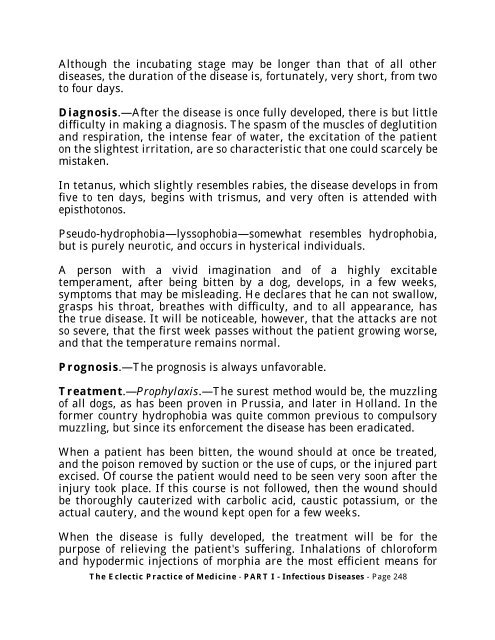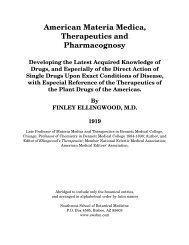SCARLET FEVER. Synonyms.—Scarlatina; Scarlet Rash. Definition ...
SCARLET FEVER. Synonyms.—Scarlatina; Scarlet Rash. Definition ...
SCARLET FEVER. Synonyms.—Scarlatina; Scarlet Rash. Definition ...
Create successful ePaper yourself
Turn your PDF publications into a flip-book with our unique Google optimized e-Paper software.
Although the incubating stage may be longer than that of all other<br />
diseases, the duration of the disease is, fortunately, very short, from two<br />
to four days.<br />
Diagnosis.—After the disease is once fully developed, there is but little<br />
difficulty in making a diagnosis. The spasm of the muscles of deglutition<br />
and respiration, the intense fear of water, the excitation of the patient<br />
on the slightest irritation, are so characteristic that one could scarcely be<br />
mistaken.<br />
In tetanus, which slightly resembles rabies, the disease develops in from<br />
five to ten days, begins with trismus, and very often is attended with<br />
episthotonos.<br />
Pseudo-hydrophobia—lyssophobia—somewhat resembles hydrophobia,<br />
but is purely neurotic, and occurs in hysterical individuals.<br />
A person with a vivid imagination and of a highly excitable<br />
temperament, after being bitten by a dog, develops, in a few weeks,<br />
symptoms that may be misleading. He declares that he can not swallow,<br />
grasps his throat, breathes with difficulty, and to all appearance, has<br />
the true disease. It will be noticeable, however, that the attacks are not<br />
so severe, that the first week passes without the patient growing worse,<br />
and that the temperature remains normal.<br />
Prognosis.—The prognosis is always unfavorable.<br />
Treatment.—Prophylaxis.—The surest method would be, the muzzling<br />
of all dogs, as has been proven in Prussia, and later in Holland. In the<br />
former country hydrophobia was quite common previous to compulsory<br />
muzzling, but since its enforcement the disease has been eradicated.<br />
When a patient has been bitten, the wound should at once be treated,<br />
and the poison removed by suction or the use of cups, or the injured part<br />
excised. Of course the patient would need to be seen very soon after the<br />
injury took place. If this course is not followed, then the wound should<br />
be thoroughly cauterized with carbolic acid, caustic potassium, or the<br />
actual cautery, and the wound kept open for a few weeks.<br />
When the disease is fully developed, the treatment will be for the<br />
purpose of relieving the patient's suffering. Inhalations of chloroform<br />
and hypodermic injections of morphia are the most efficient means for<br />
The Eclectic Practice of Medicine - PART I - Infectious Diseases - Page 248

















